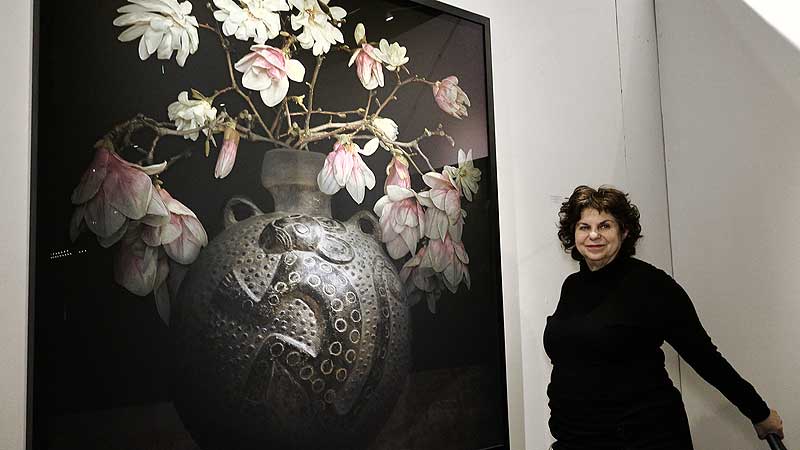- Solo Exhibition by TM Glass '150 Years Of Gardening In Canada' presented by Canada Blooms & Landscape Ontario. -
On July 1, 1867, Queen Victoria signed the British North America Act, now the Constitution Act, 1867, uniting the British colonies of Canada, Nova Scotia, and New Brunswick into one Dominion of Canada. Upon confederation, Canada was divided into four provinces: Ontario, Quebec, Nova Scotia, and New Brunswick.
In years that followed, people from Britain arrived in Canada, bringing along a rising British passion for gardening. Throughout the 19th century, enterprising sea captains imported shrubs and seeds and flower vases from Britain, China and Japan.
Plants of Pioneer and Early Days in Ontario, published in 1970 by the Garden Club of Toronto, records literary references for hundreds of flowers cultivated in early Canadian gardens. Contemporary gardeners might be surprised to know that such flowers as Anemones, Bellflowers, Hellebores, Hosta Lilies, Peonies, and Roses, began to grow in Canada centuries ago.
TM Glass combined images of these early flowers and historic vases in the collections of the Royal Ontario Museum and the Gardiner Ceramic Museum to create the still life pictures of this exhibition.
Artist TM GLASS is fascinated by the beauty of nature and the nature of beauty that springs from the complex geometrical design evident everywhere in the universe, from galaxies to the interior of each tiny cell. The works in this latest collection can be viewed as either as painterly photographs, photo collages or digital paintings. Each image is an edition of twelve prints.
Each picture is composed of several photographs taken at different times and places. Cut garden flowers were rushed to the artist’s studio to be photographed before they wilt and die. The vases were photographed at the Royal Ontario Museum and the Gardiner Ceramic Museum where curators wearing white gloves brought the vases out of cases. The artist was not permitted to touch the vases.
After shooting, the vase and flower images were merged using three kinds of computer software to create a digital file that can be printed.
The printing takes place in the artist’s studio printed by the artist on a large Epson printer. The paper is archival, museum quality, acid-free cotton rag with archival pigment inks. The pictures come in various sizes, the largest being 5x5 feet.
An alumnus of Ontario College of Art and Design (OCAD University) fine art and sculpture, TM Glass spends a good deal of time as a studio hermit. Outside the studio, TM Glass can be found passionately gardening, looking for a spot to stash a large and heavy camera on board an international flight, or cooking up a storm for friends and family.
href=/doc/v/g.aspx?1157&4> The TM Glass quest for painterly beauty sets out to combine and advance contemporary digital technology with historic concepts of beauty.
The TM Glass quest for painterly beauty sets out to combine and advance contemporary digital technology with historic concepts of beauty.
2017 COLLECTION
• White star and pink cup magnolias in an ancient American vessel, courtesy of Gardiner Ceramic Museum
• White clematis in a Chinese teapot, courtesy of Gardiner Ceramic Museum
• Onion flowers in an Ancient American tripod vessel courtesy of Gardiner Ceramic Museum
• Parrot tulips in a Japanese vase, courtesy of Gardiner Ceramic Museum
• Japanese anemones in a Japanese vase, courtesy of Gardiner Ceramic Museum
• Clematis in an Italian pharmaceutical vessel, courtesy of Royal Ontario Museum
• Siberian Iris in a Roycroft vase, courtesy of Royal Ontario Museum
• Red tulips in a Turkish vase, courtesy of Royal Ontario Museum
• White Mount Hood narcissus in a Staffordshire blue and white pitcher, courtesy of Royal Ontario Museum
• Limelight hydrangeas in a Delft tuliptree, artist’s collection
COLLECTORS
Private collections in the US, Britain, France, Australia.
-
Related materials:
- 08-Jun-2024 02:16 PM 💮 2024 Toronto Zoo Newly Renovated Greenhouse Opening 🌷🌳🌿 Photo Friendly Experience 🌹👪📷 (4K HDR, images)
- 08-Jun-2024 01:29 PM 2024 Toronto Zoo 🐻🌳🦧 Newly Renovated Greenhouse Opening Photo Friendly Experience 🌹👪📷
- 19-May-2024 02:13 PM 💮 Toronto Zoo Bonsai Ex on Victoria Day Weekend 2024 (4K HDR, images)
- 19-May-2024 01:16 PM 2024 Toronto Zoo 🐻🌳🦧 Bonsai EX on Victoria Day Weekend 💮
- 23-Jun-2019 07:12 PM 2019 Edwards Gardens. Toronto. Garden Sculptures (Images)
- 23-Jun-2019 04:07 AM 🌳🏵️🗿 2019 Edwards Gardens. Toronto. Garden Sculptures
- 23-Jun-2019 03:06 AM 🌳 2019 Edwards Gardens. Summer
- 23-Jun-2019 02:05 AM 🌳 2019 Edwards Gardens. Spring #2
- 23-Jun-2019 01:03 AM 🌳 2019 Edwards Gardens. Spring #1
- 22-Jun-2019 08:15 PM 2019 Edwards Gardens. Summer (Images)
